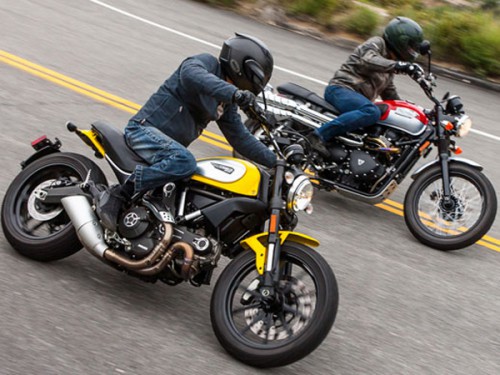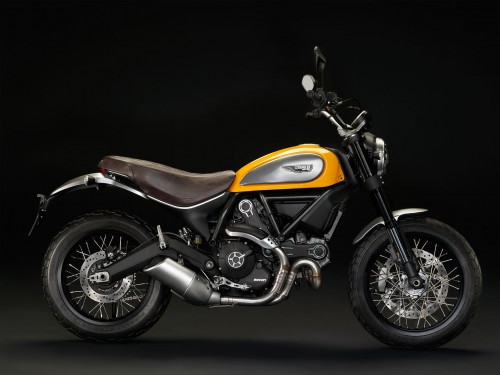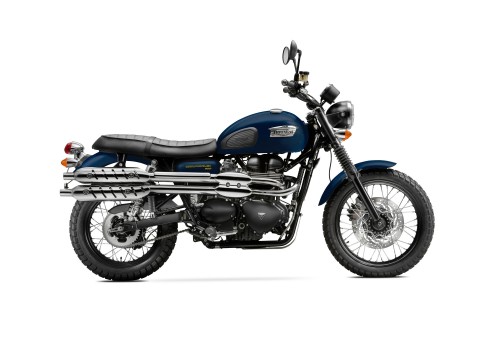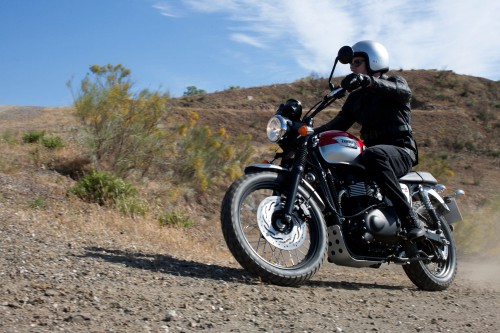The Ducati and the Triumph are two of the most popular scrambler-style motorcycles on the market today. They are, however, very different bikes in many ways. The Ducati is smaller and faster than the Triumph, but gets poorer fuel efficiency. The Triumph’s larger size and heavier weight put more limits on its off-road abilities, but it is “classier” and saves money on gas. Click though to lear which one is best.

The Ducati is lighter and faster
What Are Scramblers?
In the early 20th Century, before motorcycles were specialized and mass produced, many bike enthusiasts were accustomed to doctoring up ordinary motorcycles for use in rough and tumble “scramble” races. This became the inspiration for both the idea and name of future scramblers. By the 1960s, this type of bike was being manufactured specifically for off-road usage.
Some of the characteristics that defined a scrambler included:
- Lightweight parts
- Tough, bulky tires with spoked wheels
- High torque and power
- Exceptionally sturdy build
- Small gas tanks
- Simple, non-ornate design
- A shorter, but quite comfortable, seat
- A higher mount to gain greater ground clearance

The Ducati Scrambler is an American classic brought back to life
The Ducati Scrambler
Ducati has its headquarters in Italy, but it is owned by Audi, the same German company that produces the Volkswagen. Ducati markets its bikes worldwide and has factories both in Italy and in such far-flung lands as Brazil and Thailand.
The first Ducati Scramblers were produced specifically to be marketed in the United States between 1962 and 1974. After that, they were discontinued. A new Ducati Scrambler, however, was suddenly appeared at the German Intermot motorcycle show in 2014 and is now being marketed in 2015. Ducati caters to both a wide and a worldwide audience, and commuters in nations with few quality, paved roads are as likely to be riding on one as are contestants in an American dirt bike race.
Check these classic Scrambler-style gloves: Ducati Scrambler Overland Glove Black & Beige XX-Large
The 2015 Ducati Scrambler Icon is meant to be nostalgic of the earlier Ducati Scramblers of the ’60s and ’70s while still sporting some fresh features. At only 410 pounds, it is a low-weight bike, to say the least. Its trim size combines with its 75 hp, 8,250 rpm, and 50 foot-pounds of torque, to make it one of the fastest bikes you will likely be able to find. It is fuel injected, starts up easy from cold, revs up high, and gets 46 miles per gallon. It has standard anti-lock brakes, an anti-theft device, is steel-framed, and conforms to EU-3 emissions standards. The transmission is six-speed with a mechanical clutch, and an engine braking system eases downhill descent. The 2015 Ducati Scrambler costs around $8,500 and comes with a 24-month, factory warranty.

The Triumph Scrambler is heavier and slower but looks just as great as the Ducati
The Triumph Scrambler
Triumph Motorcycles is a British motorbike company that legally began in 1984 but that carries on the traditions of Triumph Engineering, which had its beginnings as far back as 1902. From 1989 to 2006, the principal designer for the company was John Mockett, whom we have to thank for the basic concepts involved in the modern Triumph Scrambler.
There are plenty of accessories available to the Triumph Scrambler: Triumph Scrambler Sissy Bar High Chrome A9738018
The Triumph Scrambler is designed much like a Bonneville motorcycle but with off-road stylistic features and a present, if somewhat limited, off-road ability. It has stacked, twin exhausts, high and wide handle bars, a high seat position, chrome shock absorbers, large, knobby tires, and one small headlight. It is nearly 100 pounds heavier than the Ducati, and offers 54 hp, 7,000 rpm, and 51 pound-feet of torque. It is fuel injected, starts up fast from cold, is air-cooled, and gets an impressive 60 miles per gallon. The Triumph will cost you about $9,000 and comes with a 12-month factory warranty.

2015 Triumph Scrambler in action
How do the Ducati and Triumph stack up against each other?
Both European and North American motorbike enthusiasts will find much to admire in both of these high-end, scrambler-type motorcycles. Those who want to primarily use their bike for off-road excursions, high-speed racing, and all around fun will probably prefer the Ducati. Those, however, who are willing to pay a little more for the bike itself to save on gas later on will prefer the Triumph. The Ducati scores highest of the two on maneuverability, but those who desire a heftier and more ornate kind of bike will consider the Triumph the winner. Both of these bikes are available in the U.S., Canada, the U.K., Germany, and most of mainland Europe. The Ducati is, however, preeminently an American classic brought back to life, while the Triumph is the European stand-by model.

